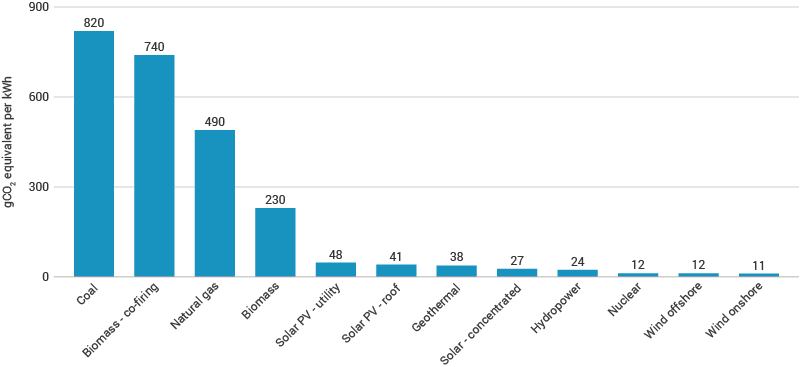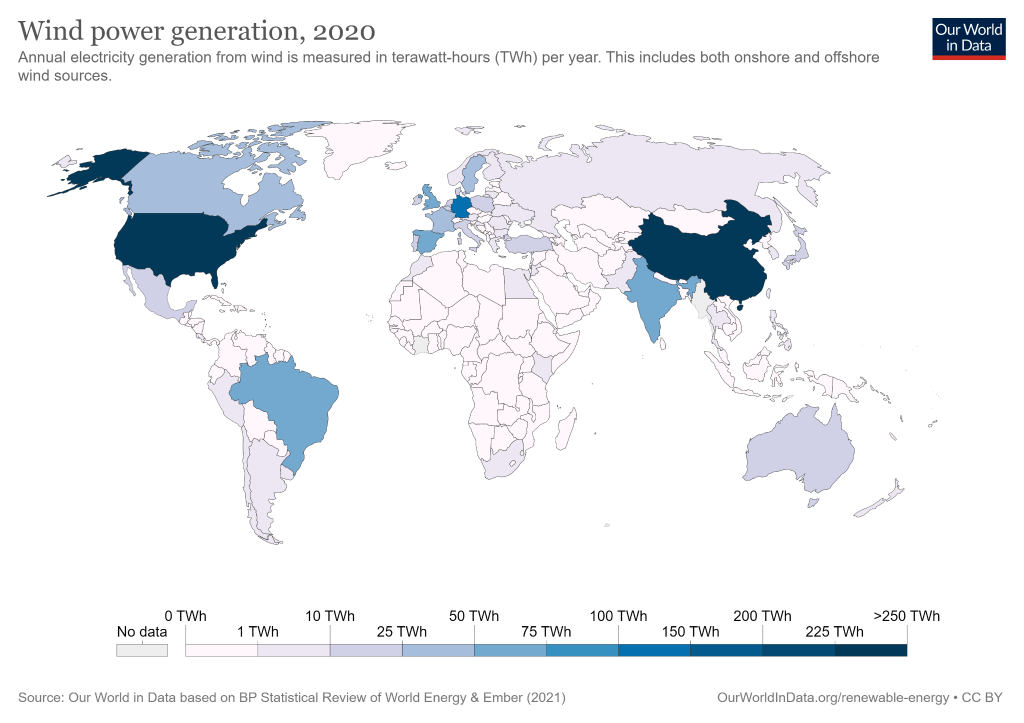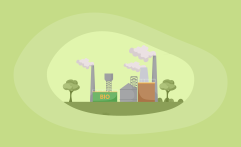What Is the Carbon Footprint of Wind Energy? A Life-Cycle Assessment
Impactful Ninja is reader-supported. When you buy through links on our site, we may earn an affiliate commission.
Learn more
Learn more
.
Hey fellow impactful ninja ? You may have noticed that Impactful Ninja is all about providing helpful information to make a positive impact on the world and society. And that we love to link back to where we found all the information for each of our posts. Most of these links are informational-based for you to check out their primary sources with one click. But some of these links are so-called "affiliate links" to products that we recommend. First and foremost, because we believe that they add value to you. For example, when we wrote a post about the environmental impact of long showers, we came across an EPA recommendation to use WaterSense showerheads. So we linked to where you can find them. Or, for many of our posts, we also link to our favorite books on that topic so that you can get a much more holistic overview than one single blog post could provide. And when there is an affiliate program for these products, we sign up for it. For example, as Amazon Associates, we earn from qualifying purchases. First, and most importantly, we still only recommend products that we believe add value for you. When you buy something through one of our affiliate links, we may earn a small commission - but at no additional costs to you. And when you buy something through a link that is not an affiliate link, we won’t receive any commission but we’ll still be happy to have helped you. When we find products that we believe add value to you and the seller has an affiliate program, we sign up for it. When you buy something through one of our affiliate links, we may earn a small commission (at no extra costs to you). And at this point in time, all money is reinvested in sharing the most helpful content with you. This includes all operating costs for running this site and the content creation itself. You may have noticed by the way Impactful Ninja is operated that money is not the driving factor behind it. It is a passion project of mine and I love to share helpful information with you to make a positive impact on the world and society. However, it's a project in that I invest a lot of time and also quite some money. Eventually, my dream is to one day turn this passion project into my full-time job and provide even more helpful information. But that's still a long time to go. Stay impactful,Affiliate Disclosure
Why do we add these product links?
What do these affiliate links mean for you?
What do these affiliate links mean for us?
What does this mean for me personally?
![]()
Wind energy is one of the fastest-growing renewable energy sources that promises the lowest levels of carbon dioxide (CO2) emissions. So we had to ask: What is the carbon footprint of wind energy?
Wind energy has the lowest carbon footprint of all energy types. On a life-cycle basis, onshore wind emits 11, and offshore wind emits 12 grams of CO2 equivalent per kWh of electricity produced. Wind energy helps combat climate change and has various additional environmental benefits.
Wind energy makes up an ever-growing amount of total energy consumption and has various environmental implications. Keep reading to learn about the overall carbon footprint of wind energy, its carbon footprint throughout its life-cycle, and its environmental impact.
How is Wind Energy Defined
Wind is a form of solar energy that is caused by the uneven heating of the earth’s surface, irregularities of the earth’s surface, and the earth’s rotation. To harness wind energy, the wind turns the turbine blades around a rotor, which spins a generator to create electricity. An average annual wind speed of 9 miles per hour (mph) or 4 meters per second (m/s) for small turbines and 13mph (5.8m/s) for utility-scale turbines is necessary to economically harness wind energy.
“Wind: a current of air moving approximately horizontally, especially one strong enough to be felt”
Cambridge Dictionary
There are two main types of wind energy:
- Onshore wind energy: Turbines are located on land. Construction, transportation, maintenance cost, and infrastructure needed to transmit electricity from onshore turbines to consumers is low. However, they may be less efficient because onshore wind speed and direction can be unpredictable.
The largest onshore wind farm in the world is the Gansu wind farm located in China. It consists of roughly 7,000 wind turbines across multiple wind farms Although it is still under construction, the planned capacity is 20 (gigawatts) GW and the current installed capacity is 8 GW.
- Offshore wind energy: Turbines are located in the ocean or freshwater. Construction, transportation, maintenance cost, and infrastructure needed to transmit electricity from offshore turbines to consumers is high. Offshore turbines are considerably larger than onshore turbines and can cost up to 20% more. Because wind speed and direction are more constant, the potential for energy generation is much higher. Noise pollution, land use, and wildlife impact concerns are minimal compared to onshore turbines.
The largest offshore wind farm in the world is the Walney Extension wind farm located in the Irish Sea. Covering 56 square miles (149 square kilometers), the 87 wind turbines have an electricity generation potential of 659 megawatts (MW) of power. This is enough to power 600,000 homes in the United Kingdom.
In the US alone, there are over 57,000 wind turbines both onshore and offshore. They can exist either as standalone structures or cluster together to form wind farms.
The two types of wind turbines are:
- Horizontal Axis Wind Turbine (HAWT): Blades are assembled on a horizontal axis parallel to the ground. They can only receive and process wind head-on.
- Vertical Axis Wind Turbine (VAWT): Blades are assembled on a vertical axis perpendicular to the ground. They can receive and process wind from all directions, giving them a greater energy generation potential.
Small, individual wind turbines can produce up to 100 kilowatts (kW) of power, which is enough to power a home or a water pumping station. Larger turbines consist of 260 foot (80 meter (m)) tall towers and 130 foot (40 m) long blades that can generate up to 1.8 MW of power. And the largest commercial turbines consist of 780 foot (240 m) tall towers and 530 foot (162 m) long blades that can generate anywhere from 4.8 to 9.5 mw of power.
What is the Carbon Footprint of Wind Energy
The carbon footprint is one of the ways we measure the effects of human-induced global climate change. It primarily focuses on the greenhouse gas (GHG) emissions associated with consumption and includes other emissions such as methane (CH4), nitrous oxide, and chlorofluorocarbons (CFCs).
“Carbon footprint: the amount of greenhouse gases and specifically carbon dioxide emitted by something (such as a person’s activities or a product’s manufacture and transport) during a given period”
Merriam Webster
Basically, it is the amount of carbon emitted by an activity or an organization. This includes GHG emissions from fuel that we burn directly (e.g., heating a home, driving a car) and GHG emissions from manufacturing the products that we use (e.g., power plants, factories, and landfills).
What Is the Overall Carbon Footprint of Wind Energy
On a life-cycle basis, onshore wind energy emits 11 and offshore wind energy emits 12 grams of CO2 equivalent per kWh of electricity produced, the joint-lowest out of all fuel types.

The Global installed capacity of wind energy increased by a factor of 75 between 1997 and 2018, growing from 7.5 GW to over 564 GW. All of the wind turbines in the world at the time covered more than 6% of global electricity demand. The market for wind power grew by over 10% in 2019 alone, with world leaders China and the US paving the way.

The six largest wind energy-producing countries (amount per year) in the world are:
- China – 221 GW
- US – 96.4 GW
- Germany – 59.3 GW
- India – 35 GW
- Spain – 23 GW
- United Kingdom – 20.7 GW
Because wind energy is one of the cheapest and fastest-growing renewable energy technologies with a low carbon emissions profile, it is important to understand what its carbon footprint is and how its carbon emissions affect the global climate change process.
To understand the carbon footprint of wind energy, we must assess its life-cycle and each stage’s carbon footprint. This life-cycle assessment (LCA) is a method to evaluate the environmental impacts of products and materials. Over the years, companies have strategically used LCA to research and create more sustainable products. So, let’s have a look at the LCA of wind energy!
| The life-cycle stages of wind energy | Each stage’s carbon footprint |
| Building of wind energy | CO2 emissions from the construction of wind power plants and electricity delivery mechanism |
| Operating of wind energy | Little to no CO2 emissions or waste products |
| Building back of wind energy | CO2 emissions from decommissioning the wind turbines and land restoration |
The total carbon footprint of wind energy would equal the carbon footprint from building + the carbon footprint from operating + the carbon footprint from building back.
What Is the Carbon Footprint of Building Wind Energy
CO2 emissions at this stage occur upon the construction of the wind farms and electricity delivery mechanism.
Many components are required to construct a wind farm, and building these components requires machinery that emits CO2. The tower, rotor, nacelle, generator, and foundation of the turbines as well as the transmission lines, transformers, and substations required for delivering electricity to consumers all have a carbon footprint.
What Is the Carbon Footprint of Operating Wind Energy
Individual wind turbines use aerodynamic force from rotor blades to turn kinetic energy into electricity. Clusters of turbines (wind farms) work together to generate large quantities of electricity.
Wind energy operates in the following manner:
- Wind flows across a turbine blade, creating a difference in air pressure across the two sides of the blade
- The blade spins in response, thereby spinning the rotor
- Spinning the rotor powers a generator which creates electricity
A wind power plant consists of many individual turbines in one location. Turbines generate electricity that is then transported to a substation where it is transmitted to consumers by transmission lines. Transformers receive the electricity and either increase or decrease the voltage as needed before it can be delivered to consumers.
There are very few CO2 emissions or waste products associated with operating wind energy, making the carbon footprint of this phase very low. CO2 emissions at this stage are associated with the operation of the mechanical equipment (e.g., turbines, generators, substations, transformers) at the power plant.
What Is the Carbon Footprint of Building Back Wind Energy
Building back wind energy involves utilizing construction equipment to decommission wind turbines and restoring the land to its original form.
Wind turbines require routine maintenance every 6 months and have a life expectancy of around 20 years. Wind turbines themselves are a valuable source of resources. The towers, foundations, generators, and gearboxes are typically recycled because they are made of concrete, steel, and cast iron. Wind turbine blades are more difficult to dispose of because they are made of composite materials. Cement co-processing is most often used to treat blade waste.
What Role Does Wind Energy Play in Combating Climate Change
Fossil fuel combustion is the main contributor to atmospheric CO2 levels. Climate Change occurs when CO2 and other air pollutants absorb sunlight and solar radiation in the atmosphere, trapping the heat and acting as an insulator for the planet. Since the Industrial Revolution, Earth’s temperature has risen a little more than 1 degree Celsius (C), or 2 degrees Fahrenheit (F). The current global annual temperature rise is 0.18C, or 0.32F, for every 10 years.
Using wind energy instead of fossil fuel energy helps mitigate the following negative effects of climate change:
- Increasing temperatures: Earth’s atmosphere has warmed 1.5℃ since 1880. This may not seem like a lot, but these degrees create regional and seasonal temperature extremes, reduce sea ice, intensify rainfall and drought severity, and change habitat ranges for plants and animals.
- Rising sea levels: Global sea levels have increased approximately 8-9 inches since 1880, displacing people living along coastlines and destroying coastal habitats. Roads, bridges, subways, water supplies, oil and gas wells, power plants, sewage treatment plants, and landfills remain at risk if sea level rise goes unchecked.
- Melting of sea ice: Since 1979, arctic sea ice has declined by 30%. Sea ice plays a major role in regulating the earth’s climate by reflecting sunlight into space and providing habitat for animal species. If all of the glaciers on Earth melted, sea levels would rise by approximately 70 feet, effectively flooding out every coastal city on the planet.
- Changing precipitation patterns: Extreme weather events (e.g., hurricanes, floods, droughts) are becoming more common and more intense. Storm-affected areas will experience increased precipitation and flooding whereas areas located further from storm tracks will experience decreased precipitation and droughts.
- Ocean Acidification: The ocean absorbs 30% of the CO2 released into the atmosphere, which decreases the pH (increases the acidity) of the ocean. In the past 200 years, the pH of oceans has decreased by 0.1 pH units, which translates to a 30% increase in acidity. Aquatic life unable to adjust to this rapid acidification will die off. A prime example of this is coral bleaching, where coral expel the algae (zooxanthellae) living in their tissues as a result of changes in temperature, light, or nutrients.
Experts claim that to avoid a future plagued by rising sea levels, acidified oceans, loss of biodiversity, more frequent and severe weather events, and other environmental disasters brought on by the hotter temperatures, we must limit global warming to 1.5C by 2040.
The more we reduce CO2 emissions, the more we slow the rate of temperature rise, sea-level rise, ice melting, and ocean acidification. When these rates are slowed, the earth’s biodiversity does not have to struggle to adapt to temperature and pH changes. People will not be displaced due to the flooding of coastal areas. And icebergs will continue to provide climate regulation.
How Environmentally Friendly Is Wind Energy
The environmental impacts of wind energy largely depend on where wind farms are constructed.
“Environmentally friendly: (of products) not harming the environment.”
Cambridge Dictionary
Overall, wind energy is sustainable because it does not emit greenhouse gases, and land use, wildlife impact, and public health concerns can be mitigated by proper planning and siting of wind farms.
What Are Environmental Benefits of Wind Energy
Here are the ways in which wind energy benefits the environment:
- Protects Air Quality: Rather than combusting materials, wind turbines harness the kinetic energy of wind to generate electricity. Turbines do not produce greenhouse gases and emit no sulfur dioxide or nitrogen oxides.
- Few Waste Products: Wind farms do not create measurable solid waste byproducts.
- Climate Change Mitigation: Wind energy has an average life-cycle CO2 equivalent emission value that is much less than coal, 11 of CO2 (onshore) and 12g of CO2 (offshore) equivalent per kWh compared to 820g of CO2 equivalent per kWh, respectively. This reduction in CO2 emissions, in turn, reduces the effects of global climate change including increasing temperatures, rising sea levels, melting of sea ice, changing precipitation patterns, and ocean acidification.
- Energy Independence: Being able to produce our own electricity in the U.S. without the aid of foreign countries is an important step to help us become more self-sufficient. Former President George W. Bush signed the Energy Independence and Security Act of 2007 to reduce U.S. dependence on oil, expand the production of renewable fuels (and confront global climate change).
- Employment Opportunities: Wind supported approximately 7,000 jobs in the US alone in 2019. And this number has likely increased because the job outlook in the next decade is 61% and the renewable energy sector collectively employed 11.5 million people worldwide in 2019. Renewable energy jobs continue to increase as we start to realize just how beneficial renewable energy is for our environment.
Throughout its life cycle, wind energy produces 0.02% of the CO2 emissions per unit of electricity than coal produces. And after 3 to 6 months of operation, a wind turbine has effectively offset all emissions from its construction, which means it can operate virtually carbon-free for the rest of its lifetime. It also creates jobs and promotes energy independence, making it an environmentally friendly energy source.
What Are Environmental Drawbacks of Wind Energy
The three main concerns associated with wind energy are land use, wildlife impact, and public health.
- Land Use: wind farms take up a substantial amount of land, but the areas between and around turbines can be used for livestock grazing, agriculture, highways, and hiking trails. The amount of land disturbed when a turbine is constructed is minimal, and they can be sited on abandoned lands to further reduce land impacts.
- Wildlife Impact: turbine blades are large and pose a threat to flying wildlife such as birds and bats. While this is true, the threat is quite minimal. Extensive research and technological advances have reduced turbine-caused wildlife death. For example, turbines are kept motionless when wind speeds are low because bats are most active at these speeds.
- Public Health: turbines can cause mechanical and aerodynamic noise pollution when constructed close to residential areas. Siting wind farms in remote locations or on abandoned lands can reduce this effect.
Proper planning and siting of wind farms can help mitigate these environmental drawbacks.
Final Thoughts
Wind energy is an environmentally friendly energy source with a low carbon footprint across its building, operating, and building back phases. It produces the lowest CO2 emissions out of all energy types while creating jobs and promoting energy independence. Environmental concerns such as wildlife impact, land use, and noise pollution can all be mitigated by proper siting of wind farms. As we look towards a future powered by renewables, wind energy is a sustainable energy source that benefits both our atmosphere and Earth’s biota.
Stay impactful,

Sources
- Office of Energy Efficiency & Renewable Energy: How Do Wind Turbines Work?
- US Energy Information Administration: Wind Explained – Where Wind Power is Harnessed
- Kiwi Energy: Differences Between Onshore & Offshore Wind Energy
- NS Energy: Profiling ten of the biggest onshore wind farms in the world
- National Geographic: Wind Energy
- Conserve Energy Future: The Comparison of Horizontal and Vertical Axis Wind Turbines
- Britannica: Carbon Footprint
- United States Environmental Protection Agency: System of Registries
- World Nuclear Association: Carbon Emissions from Electricity
- International Renewable Energy Agency: Wind Energy
- World Wind Energy Association: World wind capacity at 650,8 GW, Corona crisis will slow down markets in 2020, renewables to be core of economic stimulus programmes
- Our World in Data: Wind power generation
- Reve: Top 10 countries in wind energy capacity
- Science Direct: Life-cycle assessment (LCA)
- MIT SMR: Strategic Sustainability Uses of Life-Cycle Analysis
- Electrical Academia: Wind Turbine Parts and Functions
- Office of Energy Efficiency & Renewable Energy: How a Wind Turbine Works – Text Version
- US Environmental Protection Agency: Renewable Energy Fact Sheet – Wind Turbines
- WindEurope: What happens when wind turbines get old? New Industry Guidance Document for dismantling and decommissioning
- General Electric: Concrete Benefits – Recycling Old Wind Turbine Blades Could Help Cement Industry Cut CO2 Emissions
- Union of Concerned Scientists: The Hidden Costs of Fossil Fuels
- National Resources Defense Council: Global Warming 101
- The National Wildlife Federation: Climate Change
- National Oceanic and Atmospheric Administration: Climate Change – Global Temperature
- National Oceanic and Atmospheric Administration: Climate Change – Global Sea Level
- United States Geological Survey: How would sea level change if all glaciers melted?
- National Aeronautics and Space Administration, U.S.A.: How does climate change affect precipitation?
- National Oceanic and Atmospheric Administration: Ocean Acidification
- National Ocean Service: What is coral bleaching?
- United Nations Framework Convention on Climate Change: The Paris Agreement
- Office of Energy Efficiency & Renewable Energy: Advantages and Challenges of Wind Energy
- White House Archives: Fact Sheet – Energy Independence and Security Act of 2007
- United States Environmental Protection Agency: Summary of the Energy Independence and Security Act
- International Renewable Energy Agency: Renewable Energy Jobs Continue Growth to 11.5 Million Worldwide
- U.S. Bureau Of Labor Statistics: Wind Turbine Technicians – Occupational Outlook Handbook
- Union Of Concerned Scientists: Environmental Impacts of Wind Power
- Office of Energy Efficiency and Renewable Energy: Environmental Impacts and Siting of Wind Projects




